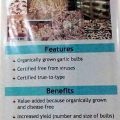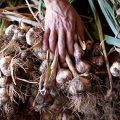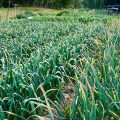No, it’s not about New Year’s Eve bawang firecracker that is the topic of this article but native garlic, the condiment that is so indispensable for many of our dishes as it adds just the right zest and tanginess to them. What is explosive is the quick multiplication of garlic planting materials in big quantities now possible with advances in Filipino knowhow.

Garlic, scientifically known as Allium sativum L., is a perennial herb that is grown throughout the world. It produces a bulb that is surrounded by sheaths that is actually composed of thin-shelled bulblets, cloves, or set, all of which are capable of forming a new plant. It is the bulblet in fresh or in processed form that is used as food, condiment, and for medicinal purposes.
In all the places that have garlic, the bulblet, either in fresh or in processed form, finds use as a condiment and as medicine (speak hypertension). It is also said to be an ingredient in the preparation of insecticides. In the Philippines it is an indispensable recado. It is simply unthinkable to have sinangag (fried rice), adobo or longanisa that does not have garlic. The crop is widely cultivated in the Ilocos region where the green tops are used for preparing the Ilocano pinakbet.
According to the Philippine Statistics Authority (PSA), garlic production in the Philippines in 2017 amounted to about 7.8 thousand mt. Production area was maintained at 2.6 thousand ha mainly in the Ilocos region. Other growing areas are Southern Tagalog, Mindoro Occidental, Central Luzon particularly Nueva Ecija, Cagayan Valley, Batanes, Bicol, and provinces in Western Visayas.
All varieties grown in the Philippines are native ones and include Batangas White, Ilocos White, and Batanes White. It is this locally-produced garlic, though smaller, that is stronger in flavor and aroma and a bit more expensive. To the discerning Filipino consumer, the cheap imported garlic that is dumped in the country lacks life and is nearly flavorless.
Garlic can only be produced vegetatively as it is sterile. As the planting materials are merely clones of one another, their use renders commercial garlic vulnerable to viral infections and pests and diseases that can cause as much as 70 percent yield loss.
Average yield of garlic in the Philippines is very low at 2.78 t/ha compared to about 10.6 t/ha in Thailand. This is due to the state of garlic planting materials which, through the years, have accumulated diseases through asexual propagation. Up until 1970, the only virus disease known was the tangle top disease. The Asian Vegetable Research and Development Center (AVRDC) has since identified onion yellow dwarf virus, garlic common latent virus, shallot latent virus, and other viruses as also present.

Local garlic production is reported to be in a decreasing trend. Simultaneously, there have been increases in the price of garlic in the local market to as much as P200 per kilo. Even as local production is exceeded by demand, the cost of production has remained high. The country, therefore, is heavily dependent on cheaper garlic imported from countries where production is more efficient. With high demand, smuggling has also thrived. Imports reached 74,000 mt in 2015, according to PSA, representing more than 90 percent of total supply, valued at $25.43 million.
For Filipino garlic producers to compete with garlic imports and thrive, productivity needs to be raised and costs reduced. One thing working in their favor is the Filipino consumer’s preference for the local garlic. Smaller in size, Philippine garlic is more potent in taste.
Obviously, producing garlic planting materials free from viral and other infections and quickly multiplied in large numbers on a sustained and regular basis is desirable. In other crops, the proven way to do this is through plant tissue culture.
Tissue culture (TC) has several applications such as cell behavior studies (cytology, nutrition, metabolism, morphogenesis, embryogenesis, pathology, etc.), plant modification and improvement, and product formation. Of immediate interest to us is the production of disease-free plants and clonal propagation of the preferred varieties.
With TC, disease-free planting materials are mass produced in capable laboratories for eventual field planting. Different parts may be taken from parent plants and “grown” under aseptic and controlled environments. A bonus is that it is not affected by the seasons as it can be done anytime.
In developing TC for garlic, researchers at the Institute of Plant Breeding of the University of the Philippines Los Baños, submitted to the Bureau of Agricultural Research (BAR) the project titled, “Utilization of the Technology of Producing True-to-Type and Certified Virus-free Garlic (Allium sativum L.) for Economic Production of Planting Materials for the Farmers”. It sought to optimally develop TC technology with economy in garlic production in mind.
The project used the tissue culture technique to micropropagate (rapid multiplication of a small amount of plant material to produce more progeny) garlic; conduct serology, molecular markers development for genetic fidelity tests, and cytology to determine if the plant materials are true-to-type; and carry out a feasibility study to determine if the technology is indeed commercially feasible. It also sought to determine the production rate of different tissue-cultured garlic varieties/ cultivars in terms of shoot and bulblet production and in terms of bulb production under greenhouse and field conditions. Several concerns to be addressed were: evaluation and utilization of local genetic diversity of garlic, the establishment of an effective seed system of garlic, and development of a standard indexing protocol for virus-free certification of garlic for effective management of the major garlic virus-diseases.
Eight studies have been carried out. Study 1 involved the collection of representative materials of the different garlic cultivars for TC. Study 2 was on in vitro culture of different cultivars. Study 3 was on virus-free certification of the different cultivars. Study 4 focused on genetic fidelity testing of different cultivars with the use of molecular markers. Study 5 was also about genetic fidelity testing but using cytological techniques. For Study 6, different varieties/cultivars were acclimatized and transferred to greenhouse and field production conditions. In Study 7, different tissue-cultured cultivars in the form of certified clean bulblets were distributed to farmers for evaluation under actual farming conditions.
Finally, Study 8 was on the economic feasibility of producing good quality planting materials of garlic, i.e., the production of true-to-type and certified virus-free bulbs of the different garlic varieties/cultivars. This was of two parts: a) feasibility study of producing in vitro bulblets from multiplied shoots, and b) feasibility study of producing bulbs under greenhouse and field conditions using tissue-cultured materials.
Micropropagation of 18 accessions of garlic has been done on a continuous basis and conserved in vitro and subjected to virus-indexing and karyotyping (a test to examine chromosomes in a sample of cells). These tissue-cultured accessions also became the basis for the production of true-to-type and certified virus-free garlic bulblets.
With the initial data collected on the field performance of TC and non TC garlic under greenhouse and field conditions, yield performance of TC garlic under field conditions (Ilocos) were already noted to increase by 65 percent. The media used for garlic shoot and bulblet production are undergoing optimization.
In developing a standard protocol for virus-free certification, several viruses (onion yellow dwarf virus, garlic common latent virus, shallot latent virus, and leek yellow stripe virus) were detected in the samples collected. Only six of the accessions were found to be virus-free and the rest have to be “cleaned”.

A number of molecular markers (22 SSR primer pairs) were tested and used for genetic fidelity tests of the different garlic cultivars. Cytological tests for genetic fidelity were also conducted.
Current results show that at 13 SSR loci, the tissue-cultured garlic are genetically the same as the non-tissue garlic. The researchers are proposing to try additional ones. With more markers tested, DNA markers can be established for variety identification of our local cultivars and for validating the genetic fidelity of tissue-cultured garlic. A diagnostic kit for genetic fidelity and cultivar identification can then be developed.
Farmer-cooperators in Iloilo and Ilocos were certified virus-free TC planting materials (bulblets) for initial field testing along with a series of trainings on the production of TC garlic, and on its planting and maintenance in the field. In Ilocos, the results were encouraging with the excellent farmer-cooperators’ performance and their readiness to adapt the tissue culture technology for commercial garlic production. Technology transfer was partially successful and needs to be intensified according to the researchers. Plans are being made to spread the technology to other farmer-cooperators in Batanes, Mindoro, Cagayan, and some areas in Mindanao.
Already, in the Department of Agriculture, TC is already being done by various agencies and Regional Field Offices (RFOs) along with partner state universities and colleges (SUCs) various crops.
The contribution of BAR has been in equipping a number of these RFOs and SUCs with tissue culture facilities and laboratories. With TC technology for garlic a reality, these facilities can turn out the production of virus-free planting materials in rapid fashion. Once the tissue-cultured planting materials reach the production areas, native garlic production can increase drastically as the cost of production shall be reduced. This will also make possible the development of a seed system that shall lead to a revival of the native garlic industry. We will thus be getting a bigger bang for our R&D buck. ###Victoriano B. Guiam
Contact details: Dr. Lilian F. Pateña University Researcher and Head Plant Cell and Tissue Culture Division Institute of Plant Breeding Crop Science Cluster, College of Agriculture University of the Philippines Los Baños College, Laguna email: lilianf.patena@yahoo.com mobile: 0929715-8669 or 0917-102-6734






